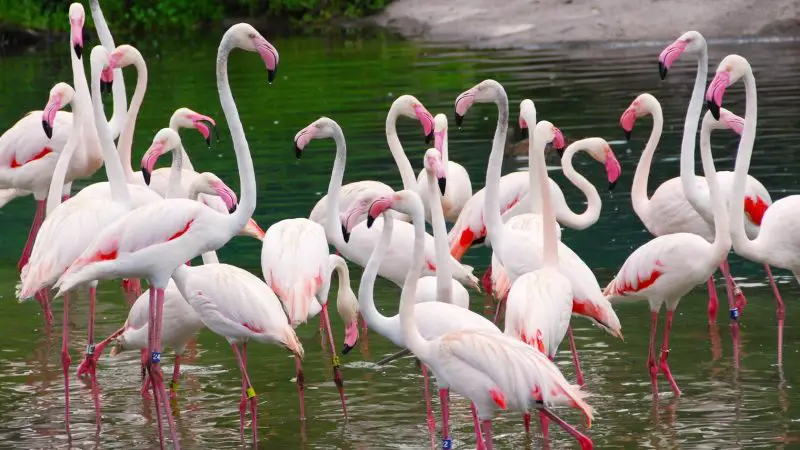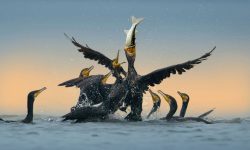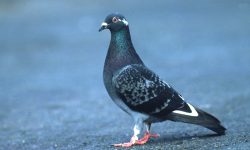Flamingos are among the most captivating and enigmatic birds on Earth. With their unmistakable pink plumage, elongated necks, and graceful postures, these birds have inspired myths, art, and scientific curiosity for centuries. But to truly appreciate flamingos is to witness them in their natural habitats, where they gather in spectacular numbers and display behaviors that can’t be captured in captivity. This article explores the top wild locations to see flamingos, diving into the science behind their preferred ecosystems and the subtle environmental cues that shape their presence.

The Flamingo at a Glance: Masters of Saline and Alkaline Worlds
Before setting foot in flamingo country, it’s essential to understand why these birds choose some of the most inhospitable landscapes on Earth. The six recognized flamingo species—Greater Flamingo, Lesser Flamingo, Chilean Flamingo, Andean Flamingo, James’s Flamingo, and American Flamingo—are all drawn to hypersaline lakes, alkaline lagoons, and mudflats, environments that most other birds avoid.
These extreme habitats may appear barren, but they are actually rich in microscopic life. They host dense populations of cyanobacteria, diatoms, and brine shrimp—organisms that thrive where few others can survive. The lack of competition in these zones gives flamingos exclusive access to food, making these harsh places surprisingly ideal.
Flamingos are highly specialized filter feeders. Their unique beaks are designed to separate tiny organisms from the water with remarkable efficiency. They feed by inverting their heads, sweeping side to side, filtering out nutrient-rich microorganisms.
Perhaps most famously, flamingos owe their vibrant pink and reddish hues to carotenoid pigments found in their diet. These pigments, especially from algae and shrimp, are processed by the bird’s body and deposited into its feathers—turning a pale juvenile into the iconic pink figure we know today.
Africa – Cradle of Flamingo Diversity
Lake Nakuru and Lake Bogoria, Kenya
In Kenya’s Rift Valley, two lakes—Lake Nakuru and Lake Bogoria—form the heart of one of the world’s most extraordinary wildlife spectacles. Here, millions of flamingos converge, transforming the alkaline waters into a vast, shimmering sea of pink that stretches across the horizon.
The star of this display is the Lesser Flamingo, a species finely tuned to exploit the unique conditions of these lakes. It feeds primarily on Spirulina, a type of blue-green algae that flourishes in the highly alkaline, mineral-rich waters. This microscopic diet not only sustains the birds in immense numbers but also enhances their vibrant color.
Lake Bogoria stands out as a geothermal wonder. With its bubbling hot springs, steaming geysers, and constant warmth, it offers an ideal incubator for algal growth. As a result, it supports one of the densest flamingo concentrations on Earth, with birds often arriving in massive flocks that shift and shimmer like living clouds.
But these delicate ecosystems are under threat. Both lakes are highly sensitive to climate fluctuations, including shifts in rainfall that alter salinity and water levels. Human activities, such as water diversion, pollution, and encroachment, further compound the stress. Protecting these lakes is not just about saving a bird—it’s about preserving a living landscape where geology, climate, and biology converge in spectacular harmony.
Etosha Pan, Namibia
In northern Namibia lies the Etosha Pan, an immense salt flat that, for much of the year, appears barren and lifeless under the sun. But during the wet season, seasonal rains transform this desolate basin into a vast, shallow lake, shimmering with reflected sky and teeming with sudden life. It’s in these fleeting waters that Greater Flamingos perform one of their most spectacular and secretive nesting rituals.
Thousands of flamingos gather seemingly out of nowhere, guided by ancient instinct and subtle environmental cues. They build cone-shaped mud nests, elevating their eggs above the delicate waterline to avoid flooding. These nests are placed close together, forming dense, organized colonies that stretch across the mirror-like surface of the lake.
The beauty of Etosha lies in its ephemeral nature. As quickly as the lake forms, it begins to recede. Once the rains subside and the pan begins to dry, the flamingos depart just as mysteriously as they arrived—leaving behind only fading footprints and a silence that lasts until the next season’s call.
This dramatic cycle of appearance and disappearance, tied so closely to climate and timing, underscores the fragile precision of flamingo migration and breeding. It also highlights the need to protect these seasonal wetlands, whose value is far greater than their fleeting presence might suggest.
The Americas – Tropical Flamingos of the Caribbean and Beyond
Yucatán Peninsula, Mexico
In the coastal lagoons of Celestún and Río Lagartos, along Mexico’s Yucatán Peninsula, the American Flamingo finds an ideal sanctuary. Unlike its African or Andean relatives, this species thrives not in high-altitude or hyperalkaline lakes, but in mangrove-fringed estuaries, where salt levels are high yet stable and food is both plentiful and diverse.
The waters here are rich in brine shrimp, tiny mollusks, and crustaceans, all packed with carotenoid pigments that maintain the flamingo’s vivid coral-pink hue. Sheltered from strong ocean currents and buffered by coastal vegetation, these brackish pools offer a perfect blend of protection, nutrition, and calm—key ingredients for feeding, roosting, and especially breeding.
Celestún, in particular, has become a symbol of sustainable ecotourism, drawing visitors from around the world. Small boats glide silently through canals lined with red mangroves, bringing people close to flocks of feeding flamingos without disturbing them. During the breeding season, lucky observers may witness the birds’ elaborate courtship rituals—a mesmerizing performance of synchronized head-flagging, wing-flashing, and communal strutting, where dozens of individuals move in perfect unison. It is not just a dance; it’s a genetic conversation, driven by instinct and reinforced by the collective energy of the flock.
These lagoons remind us that even in well-visited landscapes, wildlife and tourism can coexist—but only when ecosystems are respected and protected.
The Bahamas and Galápagos Islands
The flamingos of the Bahamas, especially those on Inagua Island, represent a rare and inspiring conservation success story. Once in sharp decline, the American Flamingo population here has made a remarkable comeback—thanks to decades of strict legal protection, careful habitat management, and salt pan restoration. These vast, shallow saline lagoons now support tens of thousands of flamingos, offering them a secure environment to feed, roost, and raise their young in relative peace. Today, Inagua is home to the largest breeding colony of flamingos in the Western Hemisphere, a living testament to what focused conservation efforts can achieve.
Farther west, in the Galápagos Islands, a small and isolated group of Greater Flamingos survives in the shadow of volcanic craters. They inhabit briny, lava-fringed lagoons, where freshwater seeps mix with ocean salt, creating a narrow ecological niche few other species can tolerate. The image is surreal: flashes of pink against the backdrop of black basalt rock and steaming volcanic slopes. These flamingos are not only beautiful—they’re also genetically distinct, having evolved in isolation for generations. With their population numbering only in the low hundreds, they are among the rarest and most vulnerable flamingo groups in the world.
Together, these sites—one a symbol of hope, the other of fragility—underscore the diverse range of habitats flamingos occupy and the urgency of protecting each unique population before it’s too late.
South America – High Altitude and Flamingo Rarity
Salar de Uyuni, Bolivia
This otherworldly salt flat—Salar de Uyuni in Bolivia, the largest in the world—transforms into a flamingo sanctuary with the arrival of the wet season. As seasonal rains spread a shallow film of water across the blinding white crust, the basin becomes dotted with mineral-rich pools, drawing in three flamingo species: James’s, Andean, and Chilean Flamingos. For a few fleeting months, this high-altitude desert bursts into motion as thousands of birds arrive to feed, mate, and nest.
What makes this gathering all the more remarkable is the altitude. At over 3,500 meters (11,500 feet) above sea level, the environment is punishing—intense solar radiation, thin, oxygen-poor air, and nighttime temperatures that plunge below freezing. Yet the flamingos thrive. They wade through icy, alkaline waters and nest on mud islands barely elevated above the surface, all while enduring conditions that few animals can tolerate.
Their success here is a striking example of avian adaptation. Scientists continue to study how these birds cope with such extremes—how they maintain core body temperature, process oxygen efficiently, and even protect their sensitive skin and eyes from ultraviolet radiation and salt exposure. The Salar is not just a breeding site; it’s a natural laboratory where evolution plays out in real time.
Laguna Colorada, Bolivia
This red-hued lake, colored by a mix of pigmented algae and mineral sediments, is more than a visual marvel—it’s a biological treasure nestled high in the Bolivian Andes. Known as Laguna Colorada, this shallow saline lake is one of the most critical breeding grounds for the elusive James’s Flamingo, a species once thought extinct until it was dramatically rediscovered in the 1950s.
The lake’s shallow, mineral-rich waters teem with microscopic diatoms, offering a reliable and concentrated food supply. As the dry season approaches, flamingos begin constructing their cone-shaped mud nests atop natural islets formed from hardened minerals and evaporites. These tiny islands offer a crucial measure of protection, helping to shield eggs and chicks from ground predators such as Andean foxes and opportunistic gulls.
Despite the lake’s harsh conditions—biting winds, freezing nights, and high UV radiation—James’s Flamingos thrive here, a testament to their remarkable specialization. In this isolated corner of the Altiplano, their vivid pink bodies dotting the crimson waters create one of the most surreal and unforgettable wildlife scenes on Earth.
Europe and the Middle East – Unexpected Flamingo Strongholds
Camargue, France
In the wide, sunlit plains of the Camargue, where the Rhône River meets the Mediterranean Sea, the Greater Flamingo finds one of its most important European strongholds. This mosaic of brackish lagoons, shallow salt pans, and reed-lined marshes forms the heart of the only known breeding population in Europe—a colony that is actively monitored and protected by conservation organizations.
Here, flamingos are more than just seasonal visitors—they are symbols of the region’s natural heritage. Each spring, thousands return from across the Mediterranean to engage in intricate courtship rituals. With synchronized movements, wing-displays, and trumpet-like calls, they turn the wetlands into a living canvas of sound and color, painting the shallows in hues of pink and coral.
What makes the Camargue especially unique is its proximity to human life. The region has long been a center for rice farming, salt extraction, and cattle herding, yet careful planning and decades of conservation work have allowed wildlife and agriculture to coexist. Flamingos nest on man-made islands and feed in restored salt flats, their presence proof that biodiversity can flourish alongside human industry—when balance is respected.
Lake Urmia, Iran
Despite facing years of ecological decline, Lake Urmia in northwestern Iran remains a vital waypoint for Greater Flamingos traversing the Middle East. Once one of the largest salt lakes in the region, its hypersaline waters continue to offer an important foraging refuge for flamingos during seasonal migrations. In peak periods, tens of thousands of birds descend upon the lake’s shimmering flats, their presence turning the desiccated landscape into a fleeting spectacle of color and motion.
Flamingos feed here on brine shrimp and microscopic algae, which thrive even in the lake’s extreme salinity. But Lake Urmia is not just a feeding station—it is a strategic stopover in a broader migratory corridor, linking Central Asia, the Caucasus, and East Africa. Its loss would ripple far beyond Iran’s borders.
In recent years, the lake has shrunk dramatically due to climate change, upstream water diversion, and drought, threatening its ability to support avian life. However, national and international restoration efforts are now underway, aiming to stabilize water inflow and recalibrate salinity levels. These initiatives represent more than environmental engineering—they are an attempt to safeguard one of the region’s last great avian crossroads, where flamingos and other migratory birds still find a tenuous hold on survival.
Conservation and the Fragile Future of Flamingo Habitats
While flamingos have evolved to thrive in some of the world’s most extreme environments, their resilience has limits. The saline lakes, alkaline wetlands, and volcanic lagoons they depend on are increasingly vulnerable to climate change, water diversion, pollution, and unsustainable salt extraction. In many regions, shrinking water levels and deteriorating water quality have already disrupted feeding and breeding cycles—signs of a larger environmental imbalance.
Flamingos are more than just charismatic birds; they are bioindicators—species whose health mirrors the condition of entire ecosystems. A decline in flamingo populations often reflects widespread ecological stress, affecting not just birds but fish, insects, plants, and even local communities that rely on wetland services.
Protecting flamingo habitats means preserving biodiversity, regulating climate, and maintaining clean water systems. These wetlands store carbon, filter pollutants, and buffer floodwaters—services that benefit both wildlife and people. In safeguarding the places flamingos call home, we ultimately protect something far greater than pink plumage—we protect the fragile balance of life in some of Earth’s most extraordinary landscapes.
Conclusion: Seeing Flamingos Is Seeing the Planet Differently
To see flamingos in the wild is to witness some of the planet’s most resilient ecosystems—harsh, ephemeral, yet astonishingly full of life. Whether it’s the alkaline basins of East Africa, the windswept Andean salt flats, or the quiet mangrove lagoons of the Caribbean, each landscape tells a story of adaptation, endurance, and ecological balance.
Watching these birds in their natural element is more than birdwatching—it’s an encounter with Earth’s ancient rhythms, cycles of flood and drought, migration and return, life blooming in conditions that seem unlivable. Flamingos remind us that beauty often takes root where we least expect it, and that the survival of the extraordinary depends on how we care for the fragile.
In protecting the places flamingos inhabit, we do more than safeguard a species. We protect the delicate threads that bind climate, water, biodiversity, and culture into something enduring and rare—a wild elegance written in pink.






